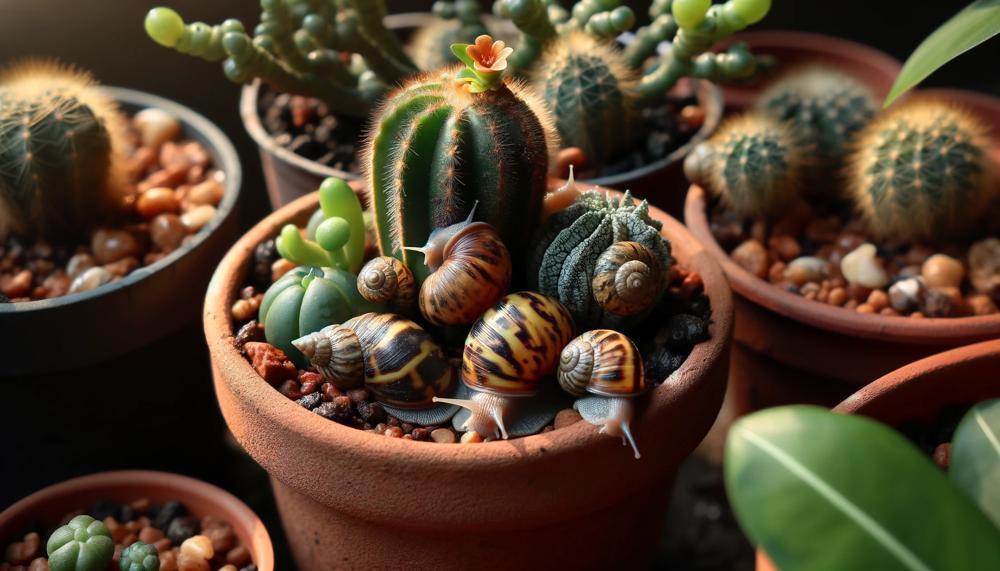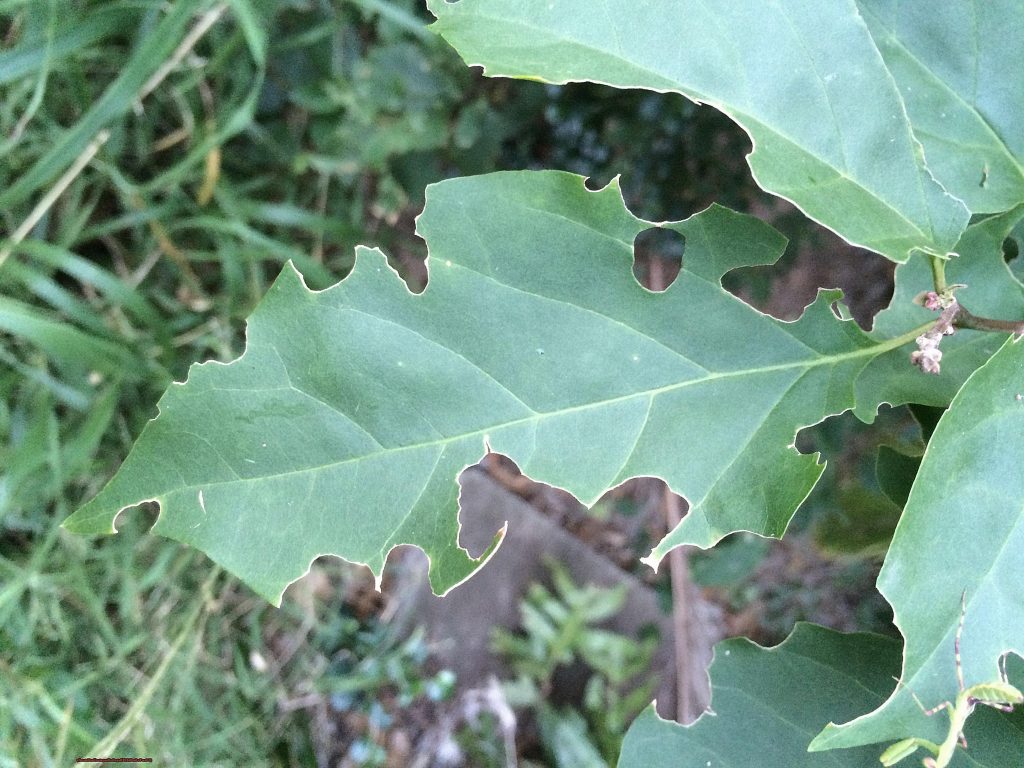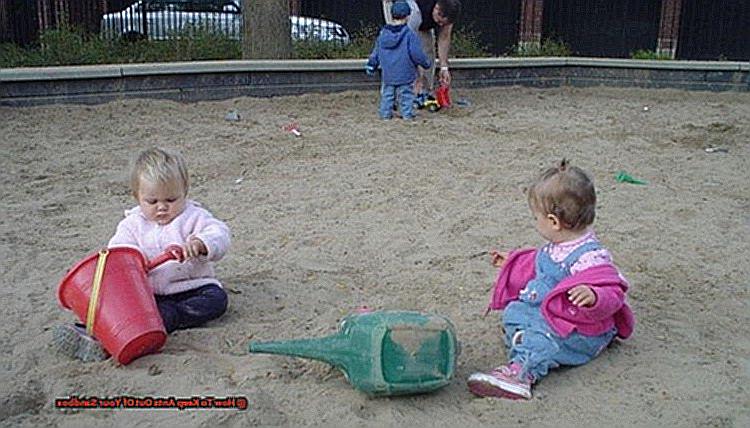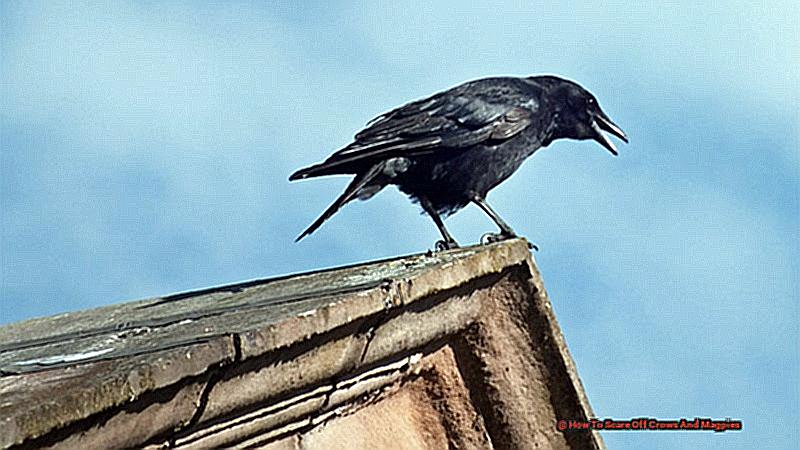Are you facing a slow-moving invasion in your potted plant paradise? Snails, those slippery little characters, are not just a nuisance; they’re voracious vegetarians that can leave your beloved plants looking like Swiss cheese overnight. But fear not, green-thumbed guardians.
There’s no need to surrender your flora to these molluscan marauders. In this blog post, we’re diving into effective, eco-friendly strategies to reclaim your pots from these slimy squatters. From DIY barriers to natural predators, we’ve got the lowdown on how to send snails packing without resorting to harsh chemicals.
So, how do you get rid of snails in potted plants?
Here are some ways to get rid of snails in potted plants:
- Organic pesticides: Spray the foliage with diluted diatomaceous earth (DE) or ground-up used coffee beans.
- Beer bait: Fill a wide-mouthed jar or bowl halfway with beer and place it in the infested area.
- Water and nematodes: Water the garden with a solution of water and nematodes, which penetrate the slug, infect it, and kill it.
- Snail traps: Fill a sunken vessel with a snail attracting substance like beer, sugary water, or yeast. Plant the bottle partially into the ground to lure the snails in, then submerge the bottle in water overnight.
- Salt: Line the edge of your plant pots with vaseline and salt. The vaseline will keep the salt in place, and as the pests climb your plant, the salt will dehydrate them and kill them.
- Baits: Baits contain a slow-acting poison that snails feed on and then die. Use baits responsibly and according to label instructions to minimize negative impacts on non-target species and the environment.
- Hand picking: Go out at night and pick snails right off the plant. Look under rocks, leaves, boards, and other possible hiding spots. Place them in buckets of soapy water.
Let’s get your potted plants snail-free and thriving.
Table of Contents
- 1 How do you tell if snails are eating my plants?
- 2 Why are there snails in my potted plants?
- 3 How to get rid of snails in potted plants?
- 4 How do I keep snails out of my potted plants?
- 4.1 Handpicking: The Old-Fashioned Way
- 4.2 Barriers: Snails’ Natural Nemesis
- 4.3 Allies in the Garden: Natural Predators
- 4.4 Diatomaceous Earth: The Sharp Solution
- 4.5 The Beer Trap: Cheers to No Snails
- 4.6 Garlic Spray: Not Just for Vampires
- 4.7 Neem Oil: The Gentle Warrior
- 4.8 Herbs: The Fragrant Guardians
- 4.9 Tidiness: A Snail’s Bane
- 4.10 The Fort Knox Approach: Physical Barriers
- 5 Can plants recover from slug and snail damage?
- 6 Conclusion
How do you tell if snails are eating my plants?
To suss out whether snails are feasting on your potted greens, keep your peepers peeled for these dead giveaways:
| Sign | Description | What to Look For |
| Holes in Foliage | Snails chomp through leaves and stems, leaving behind circular or irregular shaped holes. | Scan your plant’s leaves and stems for any unexplained openings that weren’t there before. |
| Shiny Trails | As snails meander, they leave a glistening slime trail, a bit like their own signature. | Spot these shiny tracks on the soil or draped across leaves in the early morning or after a rainy spell. |
| Nibbled Flowers | Snails have a soft spot for the soft petals and buds, often leaving them tattered or wholly consumed. | Observe if the blooms look bitten or if young buds disappear overnight. |
| Visible Snails | The most blatant clue – spotting the culprits in the act. | Look out for these slimy beings in the soil, under pots, or hidden amongst the foliage, particularly during dusk or dawn. |
| Chewed Edges | Their rasping mouthparts tear the leaf edges, leaving a jagged, torn appearance. | Examine the perimeter of leaves for uneven, ragged edges rather than smooth lines. |
Spotting these signals early can save your leafy mates from becoming an all-you-can-eat buffet for these sluggish invaders. Keep a vigilant watch, especially after a spell of rain or in the cooler parts of the day, as these are prime time for snail shenanigans.
Why are there snails in my potted plants?
Snails find their way into potted plants for a few simple yet compelling reasons. They’re in search of moisture, food, and a cozy spot to call home. Now, let’s dive into how you can keep these uninvited guests at bay.
Why Snails Fancy Your Potted Plants:
- Moisture is a big draw: Snails love damp places where they can keep their bodies moist and slide around with ease. Your well-watered potted plants are like a snail spa.
- A buffet of organic matter: Decaying leaves and other plant bits are snail delicacies. If your pots have any, it’s like ringing the dinner bell for these critters.
- A hideout: Your pots offer the perfect hideaway for snails. They can dodge predators and take a break from the heat or cold.
Keeping Snails at Bay:
| Action | Why It Works | How to Do It |
| Dry out the topsoil | Less moisture means less appeal for snails. | Water less frequently and ensure your pots have good drainage. |
| Clean up | Removing food sources makes your plants less enticing. | Regularly remove dead leaves and debris from around your plants. |
| Set up barriers | Snails are not fans of certain textures and substances. | Surround your pots with copper tape or sprinkle diatomaceous earth around. |
| Bring in the predators | Nature’s own pest control can help keep snail numbers down. | Encourage birds or introduce frog-friendly features in your garden. |
| Pick ’em off | Direct action can quickly reduce snail numbers. | Regularly inspect your plants and manually remove any snails you find. |
By tackling the root of what draws snails to your potted plants, you can turn your green haven into a no-snail zone.
Keep the soil on the drier side, clean up regularly, and maybe even make some feathered or hoppy friends along the way.
How to get rid of snails in potted plants?
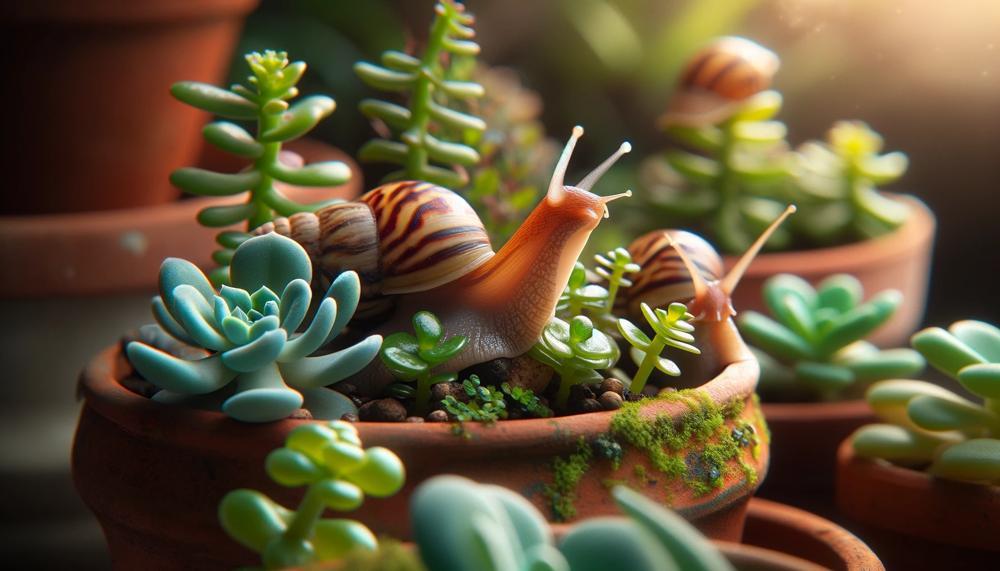
Removing snails from potted plants demands a blend of cunning and gentleness to ensure the plants stay healthy while you bid farewell to these uninvited guests.
| Method | Description | Application Tips |
| Handpicking | Physically removing snails from plants. | Best done in the early morning or evening. Wear gloves and check under leaves and near stems. |
| Beer Traps | Using beer to attract and trap snails. | Fill shallow containers with beer and place near the plants. Check and empty regularly. |
| Copper Barriers | Copper repels snails when they try to cross it. | Wrap copper tape or wire around the pot’s circumference. |
| Natural Predators | Encouraging animals that eat snails to visit your garden. | Attract birds or create habitats for frogs and beetles near your potted plants. |
| Diatomaceous Earth | A natural powder that dehydrates snails. | Spread a thin layer around your pots. Reapply after watering or rain. |
| Organic Repellents | Using substances snails find repulsive. | Surround your pots with crushed eggshells, coffee grounds, or spray with diluted garlic solution. |
Combining these strategies will help keep your potted beauties free from snail damage. Regular plant inspections and a keen eye for the early signs of infestation are your best defence.
How do I keep snails out of my potted plants?
Keeping snails at bay from your potted greens doesn’t have to be a Herculean task. A sprinkle of ingenuity, a dash of nature’s own remedies, and you’ve got yourself a garden that’s both lush and snail-free. Let’s dive into the nitty-gritty, shall we?
Handpicking: The Old-Fashioned Way
A tad laborious, yet nothing beats the satisfaction of plucking those slimy critters right off. Best done when the moon’s up or at the crack of dawn. Arm yourself with a torch, and maybe a pair of gloves, and embark on your nightly or early morning snail hunt.
Barriers: Snails’ Natural Nemesis
| Material | Why It Works | How to Use |
| Crushed Eggshells | Rough edges deter snails | Circle your pots with a generous sprinkle |
| Copper Tape | Discharges a slight electric shock | Wrap around the pot’s circumference |
| Sandpaper | Too abrasive for snail bellies | Line the pot’s outer rim |
Allies in the Garden: Natural Predators
Encourage birds, frogs, even certain insects. These critters find snails quite the delicacy. A birdbath here, a sheltered nook there, and you’ve got yourself a merry band of snail predators.
Diatomaceous Earth: The Sharp Solution
Sprinkle this powdery substance around your planters. Its microscopic sharp edges are lethal to snails, yet it’s just a ticklish path for your plants.
The Beer Trap: Cheers to No Snails
Dig a small hole, place a cup flush with the soil, and pour in some beer.
Snails, lured by the yeasty aroma, take a dip and… well, let’s just say they won’t be bothering your petunias anymore.
Garlic Spray: Not Just for Vampires
Blend a couple of garlic cloves with water, strain, and spritz over your greens.
Snails detest the smell as much as some humans do.
Neem Oil: The Gentle Warrior
A few drops mixed with water, sprayed onto your foliage, can work wonders. It’s like kryptonite for snails, but as gentle as a lamb on your plants.
Herbs: The Fragrant Guardians
Planting herbs like rosemary, mint, and thyme amongst your potted beauties works a charm.
Snails can’t stand their strong scents, and you’ll get a herb garden as a bonus.
Tidiness: A Snail’s Bane
Keep the vicinity of your potted plants as neat as a new pin. Snails love clutter; they see it as an invitation.
The Fort Knox Approach: Physical Barriers
In extreme cases, a mesh netting or a cloche can act as your plant’s personal bodyguard, keeping those slimy intruders at bay.
Can plants recover from slug and snail damage?
Yes, plants can indeed recover from slug and snail damage. The resilience and recuperation of a plant hinge on several factors like its species, the damage’s extent, its age, and the surrounding environmental conditions.
Some plants can bounce back more swiftly and robustly than others, especially those with a well-established root system.
Recovery strategies not only involve prompt care but also a blend of long-term preventative measures to shield the plants from further harm.
Immediate Care and Recovery Measures:
- Pruning Damaged Foliage: Cutting away the damaged parts of the plant can prevent the spread of disease and allows the plant to channel its energy into fostering new, healthy growth.
- Optimal Environment: Ensure the plant has the best possible conditions for recovery, including adequate water, sunlight, and nutrients.
Preventative Measures to Deter Slugs and Snails:
- Physical Barriers: Copper tape, sharp gravel, or eggshells can act as deterrents.
- Organic Repellents: Coffee grounds or diatomaceous earth spread around the plants can fend off these critters.
- Regular Inspections: Keeping an eye on your garden and removing slugs and snails by hand when spotted can significantly reduce their population.
Case Study Insights:
| Plant Type | Resilience Level | Recovery Strategy |
| Hostas | High | Prune damaged leaves; Use slug repellents |
| Annuals | Low | Protect with barriers; May need replanting |
| Perennials | High | Prune and improve conditions; Use organic deterrents |
Conclusion
A well calibrated combination of natural tactics might be your most valuable friend when it comes to fending off snail infestations of your potted plants. Without using harsh chemicals, turn your garden into a fortress against these molluscan invaders. Adopt barrier techniques such as crushed eggshells or copper tape to construct an impenetrable wall around your green treasures. Make allies with beneficial nematodes or birds to form alliances with nature’s protectors, transforming your garden into a battlefield where snails are the prey and not the predators.
It might become customary to conduct routine nighttime patrols with a flashlight as you gently remove and relocate these unwanted visitors. Modify your watering schedule to deter snail activity so that your plants will drink without turning into a vampire’s dinner. For a last line of defense, use organic baits like iron phosphate pellets to protect your flora while being mindful of the ecology.
With these considerate and environmentally friendly methods, your potted refuge may thrive without having to worry about snail damage.

